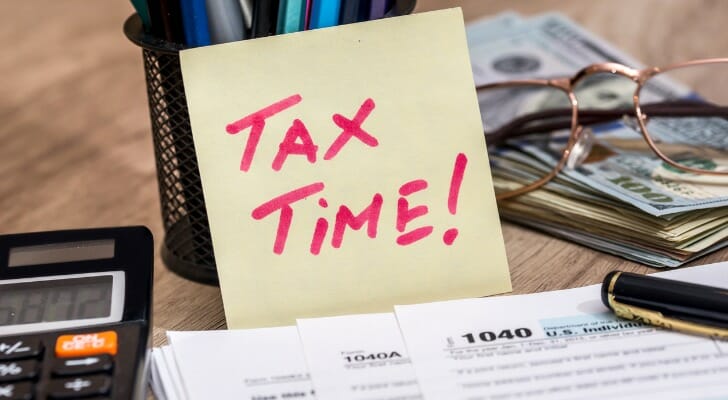 long term capital gains." width="400" height="200" />
long term capital gains." width="400" height="200" /> long term capital gains." width="400" height="200" />
long term capital gains." width="400" height="200" />
When you sell something, you’re likely looking to profit from it. Capital gains are profits from an asset sale, like your home, business, or stocks. Capital gains come in two different forms: long-term and short-term. Each faces a different tax consequence. Short-term gains are taxed as ordinary income while long-term gains are taxed at a lower rate. To understand how these capital gains might impact your assets and personal tax situation, consider working with a financial advisor who specializes in taxes.
Profits from an asset sold within a year of buying it are short-term capital gains. As a result, they’re taxed as regular income according to your tax bracket, ranging from 10% to 37%. This is considered ordinary income since the asset isn’t held for a very long period of time. Let’s take a look at the tax, depending on the bracket that you personally fall into.
For 2022, the tax bracket looks like this:
| Rate | Single | Married Filing Jointly | Married Filing Separately | Head of Household |
| 10% | $0 – $10,275 | $0 – $20,550 | $0 – $10,275 | $0 – $14,650 |
| 12% | $10,276 – $41,775 | $20,551 – $83,550 | $10,276 – $41,775 | $14,651 – $55,900 |
| 22% | $41,776 – $89,075 | $83,551 – $178,150 | $41,776 – $89,075 | $55,901 – $89,050 |
| 24% | $89,076 – $170,050 | $178,151 – $340,100 | $89,076 – $170,050 | $89,051 – $170,050 |
| 32% | $170,051 – $215,950 | $340,101 – $431,900 | $170,051 – $215,950 | $170,051 – $215,950 |
| 35% | $215,951 – $539,900 | $431,901 – $647,850 | $215,951 – $323,925 | $215,951 – $539,900 |
| 37% | $539,900+ | $647,850+ | $323,925+ | $539,900+ |

Profits from assets held for a year or more are long-term capital gains. The extra time you’ve held onto those assets could help you come tax season. Long-term capital gains are taxed at 0%, 15% and 20% depending on your taxable income. As a result, they might put you in a different tax bracket compared to short-term capital gains. For example, if you earn $100,000 a year, you’re in the 15% tax bracket. For short-term capital gains, you’d be at 24%. But your gains and losses will determine which bracket or brackets you fall into.
Here are the long-term capital gains tax rates for 2022:
| Rate | Single | Married Filing Jointly | Married Filing Separately | Head of Household |
| 0% | $0 – $41,657 | $0 – $83,350 | $0 – $41,675 | $0 – $55,800 |
| 15% | $41,676 – $459,750 | $83,351 – $517,200 | $41,676 – $258,600 | $55,800 – $488,500 |
| 20% | $459,750+ | $517,200+ | $258,600+ | $488,500+ |
Almost everything you own relates to a capital asset. Capital gains are what you earn over a certain amount of time. However, there’s also a chance you had a capital loss. A capital loss is money you’ve lost through your investments and assets. You can use those losses to lower your tax rate since losses offset gains. You’ll be able to determine how much you owe in taxes by calculating your “net” gains or losses. If your losses are more than your gains, you can deduct the difference on your tax return, up to $3,000 a year.
There are some differences when looking at both types of capital gains, but the most important difference is how each is taxed. Short-term capital gains result from selling a good or asset that you own for one year or less. Long-term capital gains are taxed at a more favorable rate because you’re selling an asset that you’ve held for longer than one year. Short-term capital gains are taxed as ordinary income while long-term gains are taxed at a significantly lower rate, in many instances. The total amount of tax savings will depend on what tax bracket you would fall into with a short-term gain, as seen above.

There are a few ways to offset capital gains taxes. They include:
The difference between short-term and long-term capital gains could be the difference between a big tax bill and a smaller one. When buying and selling assets, consider how long you’ve owned them and how much tax you’ll pay on them in the near future. Short-term capital gains consist of profits from an asset sold within a year of purchase. They face a tax rate similar to regular income: Between 10% and 37%. However, if you hold onto assets for a year or more, they’re long-capital gains. Taxes on those gains top out at 20%, but may be as little as 0%. Meanwhile, if you take a capital loss, you can either deduct the loss this year or carry it over into a year when you make more income.
Photo credit: ©iStock.com/cnythzl, ©iStock.com/alfexe, ©iStock.com/skynesher
Dori ZinnDori Zinn has been covering personal finance for nearly a decade. Her writing has appeared in Wirecutter, Quartz, Bankrate, Credit Karma, Huffington Post and other publications. She previously worked as a staff writer at Student Loan Hero. Zinn is a past president of the Florida chapter of the Society of Professional Journalists and won the national organization's "Chapter of the Year" award two years in a row while she was head of the chapter. She graduated with a bachelor's degree from Florida Atlantic University and currently lives in South Florida.
Read More About Financial Advisor



More from SmartAsset
SmartAsset Advisors, LLC ("SmartAsset"), a wholly owned subsidiary of Financial Insight Technology, is registered with the U.S. Securities and Exchange Commission as an investment adviser. SmartAsset's services are limited to referring users to third party advisers registered or chartered as fiduciaries ("Adviser(s)") with a regulatory body in the United States that have elected to participate in our matching platform based on information gathered from users through our online questionnaire. SmartAsset receives compensation from Advisers for our services. SmartAsset does not review the ongoing performance of any Adviser, participate in the management of any user's account by an Adviser or provide advice regarding specific investments.
We do not manage client funds or hold custody of assets, we help users connect with relevant financial advisors.
This is not an offer to buy or sell any security or interest. All investing involves risk, including loss of principal. Working with an adviser may come with potential downsides such as payment of fees (which will reduce returns). There are no guarantees that working with an adviser will yield positive returns. The existence of a fiduciary duty does not prevent the rise of potential conflicts of interest.